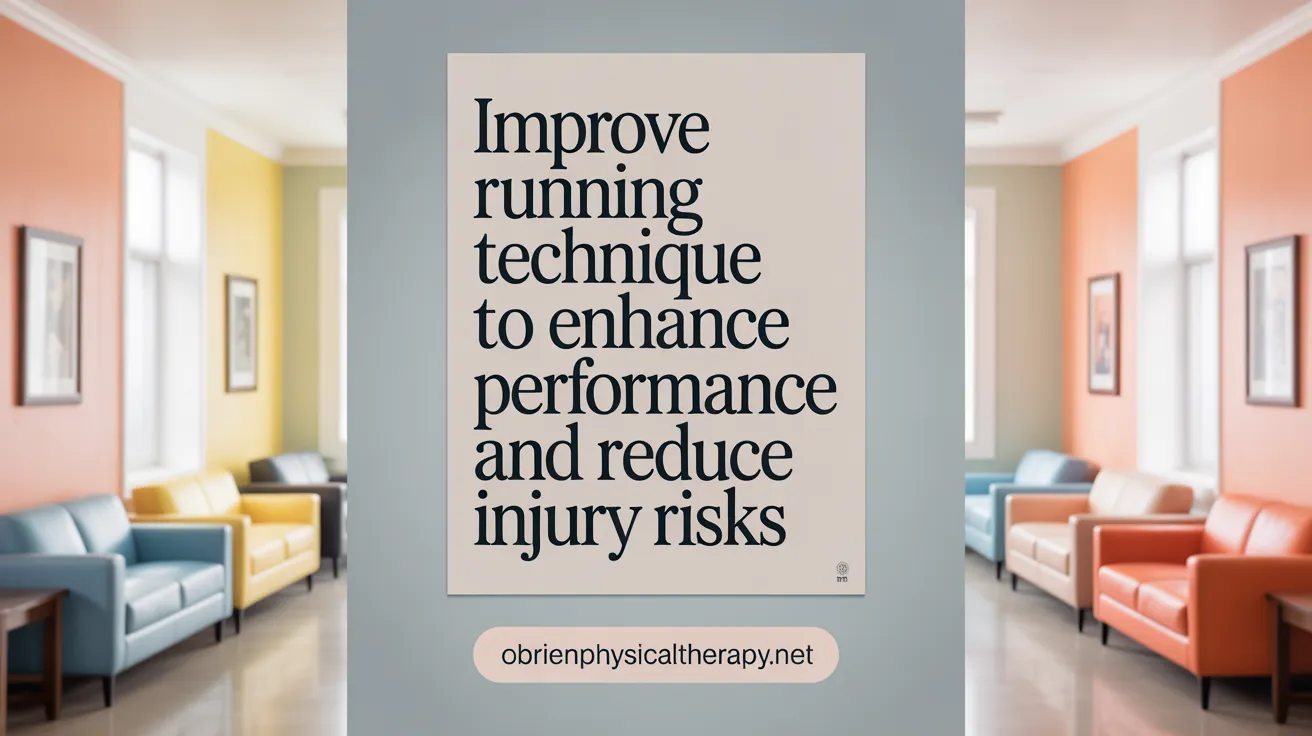Introduction to Injury-Free Running
Running is a popular and effective way to maintain fitness, but it comes with a risk of injury, especially if precautions aren't taken. This article provides a comprehensive overview of strategies to prevent common running injuries, addressing training methods, form, equipment, nutrition, and recovery. By understanding key risk factors and adopting smart approaches, runners at all levels can enjoy safer, more sustainable running experiences.
Understanding Causes and Risk Factors of Running Injuries

Why do runners often get injured easily?
Runners are vulnerable to injuries mainly because of overuse and improper training practices. Increasing mileage faster than 10% per week can overstrain bones, muscles, and tendons, leading to injuries like stress fractures and shin splints. Poor biomechanics, muscle weaknesses, and improper running form create additional stress on joints, which can cause runner’s knee, IT band syndrome, and other overuse injuries.
Inadequate recovery time, unsuitable footwear, and sudden terrain changes also contribute to injury risk. Weak core and hip muscles often cause compensatory movements, increasing stress on other body parts. To prevent injuries, runners should increase their training gradually, strengthen supporting muscles, wear appropriate shoes, and listen to their body's pain signals.
How can runners recognize causes and risk factors of their injuries?
Runners can identify injury causes by monitoring symptoms and training habits closely. Early signs like sharp pain, swelling, or persistent soreness signal potential issues. Recognizing biomechanical issues—such as overstriding, uneven gait, or worn-out shoes—helps pinpoint risk factors.
Awareness of personal factors like previous injuries, body type, and age also plays a role. For instance, knee pain might stem from weak quadriceps or flat feet, while lateral hip pain could be linked to insufficient glute strength. Regular gait analysis and medical check-ups can uncover underlying mechanics that predispose runners to injuries.
By paying attention to symptoms and understanding their training patterns and biomechanics, runners can take steps to prevent injuries or seek early medical care. Incorporating strength training, proper footwear, and gradual mileage increases form the foundation of injury prevention.
Designing Safe Training Plans and Progressions

What are safe training plans and progression methods to avoid running injuries?
A safe running training plan emphasizes gradual progression and attentiveness to the body’s signals. One fundamental approach is adhering to the 10% rule, which stipulates increasing weekly mileage by no more than 10%. This steady escalation allows muscles, tendons, and bones to adapt gradually, reducing overuse injuries such as stress fractures or tendinitis.
In addition to measuring mileage, it's crucial to avoid increasing speed and distance simultaneously. Focus on one aspect at a time—either gradually increasing the pace or the distance—to minimize strain on your body.
Proper rest and recovery days are essential components of any plan. Incorporate at least one full rest day per week, and include easy or active recovery sessions following intense workouts. Adequate sleep, hydration, and nutrition play supporting roles in injury prevention.
Cross-training exercises such as cycling, swimming, or elliptical workouts reduce joint impact, provide cardiovascular benefits, and help develop supporting muscles. Strength training targeting core muscles, hips, and legs enhances stability and resilience.
Monitoring signs of early fatigue, soreness, or pain allows timely intervention. If persistent pain or swelling occurs, seeking medical advice ensures proper diagnosis and prevents worsening injuries.
A gradual, well-structured return-to-running after injury also reduces recurrence risks. Combining these strategies—progressive load increases, balanced training, appropriate footwear, and attentive care—helps maintain safe and sustainable running routines.
How often should one run to prevent injury?
Injury prevention begins with appropriate frequency based on experience and individual capacity. Beginners are generally advised to run 2 to 3 times weekly, allowing ample recovery between sessions. These rest periods help muscles recover and prevent overuse injuries.
As fitness improves, more experienced runners can safely train 3 to 5 days per week, provided they include rest days and vary mileage or intensity. The inclusion of at least one complete rest day each week remains a cornerstone of injury prevention.
Advanced runners training 5 to 6 days can do so by carefully managing workload, emphasizing proper recovery, and listening to their bodies for signs of fatigue.
Ultimately, maintaining a balance of run days and rest days ensures the body adapts healthily, reducing the risk of common injuries like stress fractures, IT band syndrome, or muscle strains. Tailoring training frequency to individual needs, goals, and response helps sustain a lifelong running practice.
Optimizing Running Form and Technique to Reduce Injury Risk

How does proper running form and technique contribute to injury prevention?
Proper running form is essential for avoiding injuries because it promotes even distribution of forces across muscles and joints. When runners maintain an upright posture with relaxed shoulders, a straight back, and a stable core, they reduce strain on their neck and back muscles.
One of the most important aspects of running form is the foot strike. Aiming for a midfoot or forefoot strike can help absorb shock better than a heavy heel strike, which often increases stress on the knees and shins. Running with a slight forward lean of about 5 to 10 degrees also contributes to better propulsion and reduces impact forces.
Avoiding overstriding — where the foot lands too far in front of the body — is crucial. Overstriding increases impact on the knees and can lead to injuries like runner’s knee or shin splints. Instead, aims for a cadence of at least 170 steps per minute, which helps minimize impact and improves running efficiency.
Supporting good form involves strengthening key muscles, such as those in the hips, core, and legs. Proper footwear and warm-up routines further promote correct mechanics. Regular gait analysis, whether through professional assessment or self-monitoring, can identify faulty movement patterns that may predispose you to injury.
How to improve your running form:
- Maintain an upright posture with a slight forward lean.
- Keep shoulders relaxed and aligned with hips.
- Land on the midfoot or forefoot rather than heel striking.
- Increase cadence gradually to reduce impact.
- Strengthen supporting muscles through targeted exercises.
- Use gait analysis to identify and correct improper movement patterns.
By focusing on these elements, runners can significantly lower their risk of common injuries and enjoy a healthier, more efficient running experience.
Effective Injury Prevention Exercises and Stretching Routines

What are effective injury prevention exercises and stretches for runners?
Running progressions should include both dynamic warm-up routines and static stretching to prevent injuries. Before each run, engaging in dynamic warm-ups like hip circles, leg swings, butt kicks, high knees, and walking lunges helps prepare muscles for activity. These movements increase blood flow and improve joint mobility, reducing the risk of strains and overuse injuries.
Post-run stretching focuses on key muscle groups affected by running, including the hamstrings, quadriceps, hip flexors, calves, and glutes. Static stretches such as the Hip Flexor to Hamstring stretch, Standing Quadriceps Hold, and Seated Hamstring stretch help maintain flexibility and prevent tightness that could lead to injuries.
Strengthening exercises complement stretching by targeting specific muscles to stabilize joints and improve running form. Core exercises like planks and bridges, along with strengthening routines for the hips and legs—such as squats, lunges, clam shells, and calf raises—help reduce common injuries like runner's knee, IT band syndrome, and Achilles tendinitis.
In addition, mobility exercises like cat-cow stretches, hip circles, and ankle rotations performed two to three times weekly enhance joint flexibility. These routines, when integrated consistently, can significantly lower injury risk, helping runners maintain strong, flexible muscles capable of absorbing impacts more effectively.
Choosing Appropriate Footwear and Running Environments

Importance of Well-Fitted Running Shoes
Proper running shoes are essential for injury prevention. They should fit well, supporting your foot's unique shape and biomechanics. The shoe's length should allow about a thumb’s width of space at the toes, and the heel should fit snugly without slipping. Shoes designed specifically for running provide cushioning, stability, and arch support, reducing the risk of overuse injuries.
Shoe Replacement Frequency
Worn-out shoes lose their cushioning and structural support, increasing injury risk. It is recommended to replace running shoes every 300 to 400 miles, depending on your running style and shoe material. Regularly inspecting shoes for signs of wear, such as worn-out soles or reduced cushioning, helps determine when it’s time to buy new footwear.
Effects of Shoe Type on Injury Risk
Different shoe types cater to various foot types (flat feet, high arches, neutral). Using shoes that match your foot’s needs can improve biomechanics and prevent issues like plantar fasciitis or shin splints. Overly stiff shoes may restrict natural movement, while overly flexible shoes might lack support. Consulting a specialist or performing a gait analysis can guide you in choosing the best shoes.
Safe Running Surfaces
Running on even, soft surfaces such as grass, dirt trails, or synthetic tracks minimizes joint impact and reduces injury risk. Avoid hard surfaces like concrete, which increase the shock transmitted through your joints. Gradually introducing surface changes, such as starting on softer terrain before moving to harder ground, helps your body adapt.
Running Safety Tips Including Visibility and Route Selection
For safety, choose well-lit, populated routes, especially when running at dawn or dusk. Wearing reflective clothing and gear enhances visibility for drivers and other pedestrians. Inform someone about your route, carry a mobile phone for emergencies, and avoid isolated areas. These practices help ensure a safe running experience.
Hydration, Nutrition, and Recovery Strategies for Injury Prevention
Proper hydration, nutrition, and effective recovery are crucial components of injury prevention for runners. Staying well-hydrated before, during, and after runs helps maintain muscle function, prevent cramps, and avoid heat-related illnesses. Drinking water regularly supports tissue health and keeps joints lubricated, reducing the likelihood of overuse injuries. Electrolyte intake is equally important; it sustains nerve function and muscle contractions, minimizing fatigue and cramping.
Nutritional support accelerates recovery and strengthens musculoskeletal health. Consuming a balanced diet with adequate carbohydrates and protein within 30 to 60 minutes post-exercise replenishes glycogen stores and repairs muscles. Micronutrients like calcium, magnesium, and vitamin D are vital for bone strength and overall resilience.
Adequate sleep, approximately seven and a half to eight hours per night, is essential for optimal recovery, allowing muscles to repair and immune functions to operate efficiently. As training intensity increases, so should sleep duration to support tissue regeneration.
Using recovery modalities such as ice packs, massage, foam rolling, and heat therapy can reduce inflammation, improve flexibility, and alleviate muscle soreness. Recognizing the difference between normal soreness and persistent or sharp pain is vital. Pain that impacts gait or does not subside after 10 minutes of rest warrants medical evaluation.
Recovery plays a pivotal role in preventing overuse injuries like plantar fasciitis, tendinopathies, and stress fractures. Implementing a structured regimen that includes rest days, proper nutrition, hydration, sleep, and modalities like massage or foam rolling ensures the body correctly heals and adapts to training loads, promoting long-term injury resistance.
| Aspect | Purpose | Recommendations |
|---|---|---|
| Hydration | Prevent dehydration and maintain tissue health | Drink water before, during, and after runs; consider electrolyte drinks if sweating heavily |
| Nutrition | Support tissue repair and fuel recovery | Consume carbs and protein within 30-60 min post-exercise; include micronutrients |
| Sleep | Facilitate muscle repair and immune function | Aim for 7.5-8 hours, increase with training intensity |
| Recovery Modalities | Reduce inflammation, enhance flexibility | Use ice, massage, foam rolling, heat; listen for pain signals |
Final Thoughts on Staying Injury-Free
Preventing running injuries requires a multifaceted approach combining smart training progression, attention to proper running form, appropriate footwear, strategic cross-training, and diligent recovery practices. Recognizing risk factors early and responding promptly to pain or discomfort can safeguard against severe injuries. By embracing these strategies, runners not only enhance performance and endurance but also ensure a long-lasting, enjoyable running journey free from the setbacks of common injuries.
References
- The 6 Most Common Running Injuries & How to Prevent Them
- Become a better runner, avoid injury - Mayo Clinic Health System
- Sports Injury Prevention | Running | Boston Children's Hospital
- Running and jogging - preventing injury | Better Health Channel
- Running Injuries: The Ultimate Runner's Guide to Injury Prevention
- Preventing running injuries. Practical approach for family doctors
- 10 Common Running Injuries: Prevention and Treatment - WebMD
- 6 common running injuries and how to avoid them
